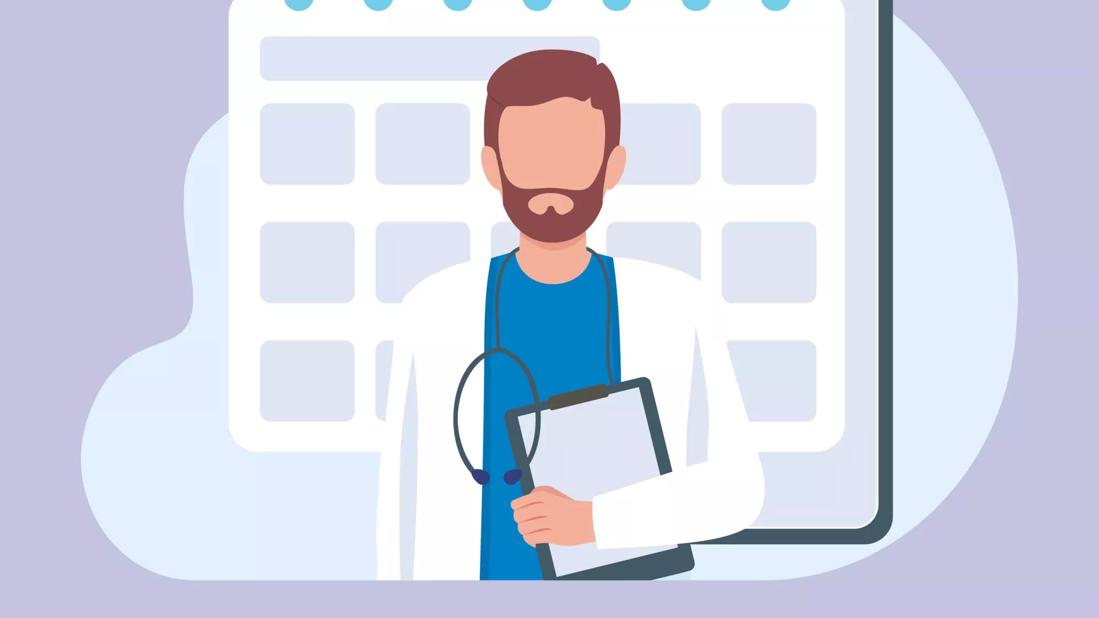Screenings and tests done during a wellness check can uncover hidden health issues

If you’re an adult male, the odds are good that you’ve avoided scheduling a regular health screening.
Advertisement
Cleveland Clinic is a non-profit academic medical center. Advertising on our site helps support our mission. We do not endorse non-Cleveland Clinic products or services. Policy
SPOILER ALERT: That’s not the best idea, especially when the candles start to add up on your birthday cake.
Regular physical exams offer important insight into your health and body as you age. It’s a way to detect health issues before they become … well, significant health issues.
Yet a 2023 survey by Cleveland Clinic found that almost half of men (44%) DO NOT get an annual physical. The survey was done as part of Cleveland Clinic’s national MENtion It® educational campaign.
Perhaps knowing what happens during a physical exam can help change that number for guys. For more on what to expect during a screening, we turn to primary care specialist Daniel Sullivan, MD.
Think of a wellness exam as an opportunity to verify that you’re as healthy as you think you might be.
Not every issue in your body is an obvious one, after all. Bruises and broken bones are easy to see. But it’s a little tougher to spot high cholesterol levels or elevated blood sugar with the naked eye.
Tests done during a standard wellness exam can reveal “hidden” issues that deserve attention.
“You can’t treat a condition if you don’t know it’s there,” notes Dr. Sullivan. “Once we learn about an issue, we can consider options to appropriately address it and prevent an illness down the line.”
Advertisement
If you’re in good health, the general recommendation is to start getting regular wellness exams at age 35. “After that, if you’re feeling good, going once every few years is plenty until age 50,” says Dr. Sullivan.
Then, once you cross the half-century mark, an annual checkup is recommended given age-related health issues that become more common. These would include:
Consider those timetables very general, though. More frequent wellness screenings may be called for depending on your personal health history, your family’s health history or lifestyle habits (such as smoking).
Many of the tests done during a routine health exam are the same regardless of sex or age. Others are a bit more specific to men or your age.
Let’s break it down.
The start of an exam for everyone typically includes some basic tests to offer a quick health snapshot. You can expect tests looking at:
A blood test also is generally included as part of a general wellness check, notes Dr. Sullivan. (The blood draw may be done on a separate day from your main office visit given fasting requirements.)
A blood test offers a look at cholesterol and blood sugar levels, “hidden” factors that could show the potential for heart disease and diabetes.
In addition, it can screen for viruses like HIV (human immunodeficiency virus) and hepatitis C.
“If you were exposed to either of those viruses, which you could pick up through sexual contact or something inadvertent, there are staggeringly effective treatments to put the fire out,” says Dr. Sullivan.
The prostate is a small gland that’s part of the male reproductive system. It’s also a common spot for cancer to appear — especially later in life. (Fact: On average, 1 in 8 men will be diagnosed with prostate cancer during their life.)
It’s recommended that prostate cancer screenings begin by age 55 and continue through age 75.
“A screening may find the cancer sooner, and early treatment is better than waiting for symptoms,” states Dr. Sullivan. “It’s important to have a conversation on this to decide what path you want to take.”
Testing is typically done one of two ways:
Advertisement
Did you know that testicular cancer is the most common cancer in younger males (ages 15 to 35)? “It’s a cancer of young men,” says Dr. Sullivan.
During a wellness exam, your healthcare provider may check your testicles for any hard lumps that may signal cancer. An early diagnosis is key, as testicular cancer is very treatable with a cure rate of 95%.
(On a side note, taking two minutes once a month to do a self-exam of your testicles is highly recommended. It’s a simple process, too.)
While a colon cancer screening won’t be done in the office during your physical exam, expect to chat about your options during your visit.
Colon cancer screenings are generally recommended beginning at age 45, says Dr. Sullivan. In some cases, elevated risk factors (such as a family history of the disease) may warrant earlier testing.
Advertisement
It should be noted, too, that colon cancer is becoming more common in younger adults.
The “gold standard” for a colon cancer screening is a colonoscopy, a procedure where cancer-causing polyps can be found and removed. “A cancerous polyp that’s in the trash can can’t hurt you,” says Dr. Sullivan.
Some people opt for a stool test for colon cancer screening. In this test, you send a sample of … well, poop to a lab for testing. The tests can detect colon cancer but are not as accurate as a colonoscopy.
Expect to have a conversation about healthy living. (After all, that’s why you’re at this exam, right?) Expect to chat about the importance of exercise and nutrition for keeping your body in tip-top shape.
A wellness check also offers an opportunity to talk about (or get) vaccines, including:
“An annual checkup is a time to talk about things that will improve not only your length of life, but your quality of life,” reassures Dr. Sullivan. “It’s worth the investment of time.”
Advertisement
Learn more about our editorial process.
Advertisement

Signs are what your provider can see, but symptoms are what you feel or experience

An annual physical exam is important for many reasons, including your chance to ask questions

From odors to colors, it’s more than OK to ask your doctor these questions

This iconic medical tool has an enduring role

Simple tips to make your visit more effective

Tips to help you get the most from your visit

What you really want to know about what's going on down there

Arousal without orgasm can be uncomfortable, but it’s no reason to pressure sexual interactions

Babies can get congested easily, but you can calm their cough by keeping them hydrated, using nasal drops and running a humidifier

Weight loss may cause loose, sagging skin and muscle loss to your rear

Several conditions, like vitiligo and fungal infection, can cause a loss of pigmentation, leading to white spots or patches on your skin